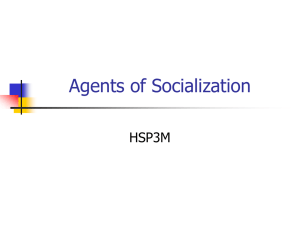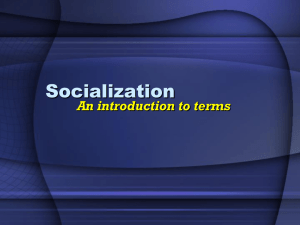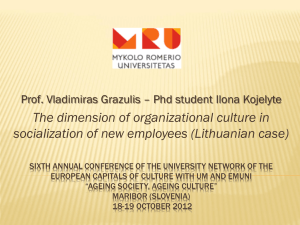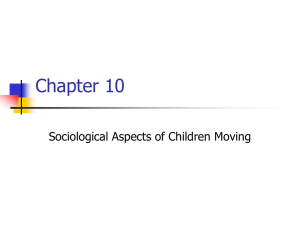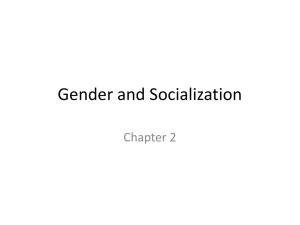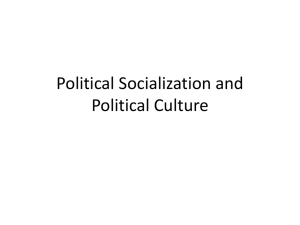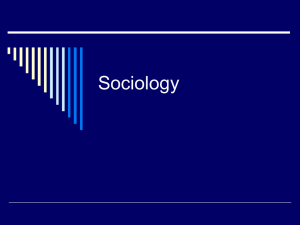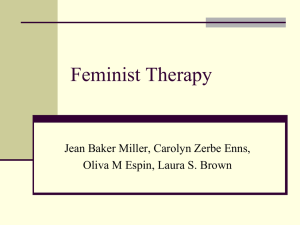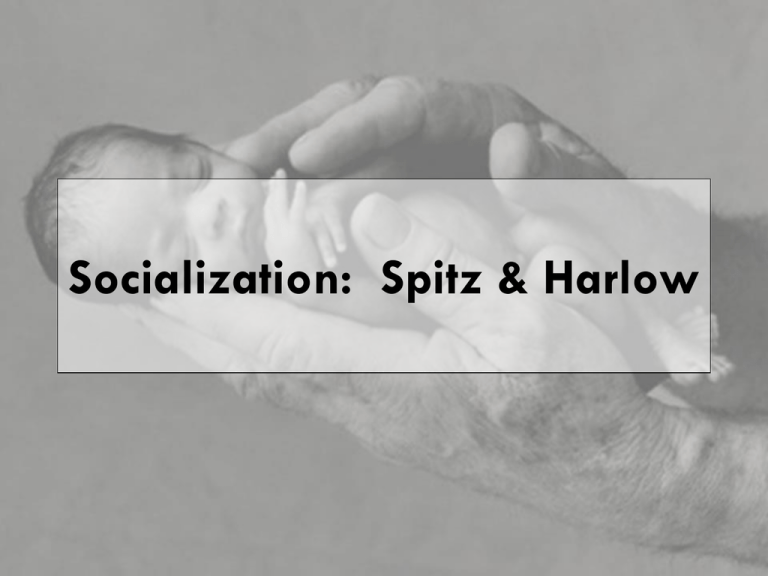
Socialization: Spitz & Harlow
Key Concepts
• Socialization
• Nature vs. nurture
• Resocialization
• Total institutions
• Agents of socialization: family, peers, school
Nature vs. Nurture: A bit of review…
• Nature v. nurture debate – examines the relative
importance of cultural and biological factors in the
developmental process of human beings
• The answer?
• A complex interaction between the two
• Biology – provides us with large brains that allow us to
think abstractly
• Learning (Conditioning) begins at the moment we are born
• Twin studies help social scientists document the effects
of learning and genetics
Society’s Survival
• Humans (and animals) need physical contact
with others
• It is essential to meet social and emotional needs
• Survival of the individual, society and culture,
depends on members being properly socialized
• Evidence to support this claim?
Evidence
•
Feral & Isolate
Children – Genie (lack
of social skill
development)
•
Institutionalized
Children – Rene Spitz
•
The Harlow Study –
Harry Harlow
Rene Spitz
• Interested in the
relationship between
mother and child, and
healthy attachment
• Explored the
development (or lack of
development) of
institutionalized children
• 1945 Study of
institutionalized children
Rene Spitz (Cont’d)
• The children:
• All were 3 years or younger
• 45 babies in total – some were put with foster
homes, some in institutions (e.g. nursing home)
• Institution – raised babies:
• Given minimal care (not cuddled or played with)
• No stimulation
• Raised by nurses who worked 8 hour shifts
Spitz – Findings
• After 2 years:
• Babies raised in the institutional (nursing home)
environment suffered seriously
• More than 1/3 died
• 40 years later, 21 of those raised in the nursing
home were still in institutions
• Most were severely retarded (physically, mentally,
verbally, and/or socially)
Harry Harlow’s Monkey Experiments
• Harlow’s monkey experiments
• Summary:
• Separated baby monkeys from their mother 6 –
12 hrs after birth
• Placed them with surrogate mothers of either wire,
OR cloth; wire had food, cloth had a heat source
inside
Harry Harlow’s Monkey Experiments
• Summary:
• Separated baby
monkeys from their
mother 6 – 12 hrs after
birth
• Placed them with
surrogate mothers of
either wire, OR cloth;
wire had food, cloth had
a heat source inside
Fig: Harlow with monkey
Herman, E. (2005). Harry F. Harlow: Monkey
Love Experiments. Retrieved April 10, 2007,
from http://darkwing.uoregon.edu/
~adoption/studies/HarlowMLE.htm
Harlow’s Findings (Cont’d)
• Babies preferred cloth
monkey 23 hrs/day
• Moved to wire monkey only
when hungry
• As adults, the monkeys were
seriously disturbed:
• Very strange behaivours
• Did not know their cultural
behaviour patterns
Fig: Monkey with Surrogate Mothers
Herman, E. (2005). Harry F. Harlow: Monkey
Love Experiments. Retrieved April 10, 2007,
from http://darkwing.uoregon.edu/
~adoption/studies/HarlowMLE.htm
Spitz & Harlow’s Work
• Conclusions?
• Need for loving contact and stimulation to develop healthily
• People need physical contact throughout life
• Isolation brings on abnormal behaviour (e.g. isolation,
anxiety, etc.)
• Healthy child development requires forming a healthy bond
–from birth
• Healthy development lends itself to normal socialization
Socialization: the Key to Society’s Survival
• Socialization is learning
• All learning regardless of setting or age of the
individual
• Survival of the individual, society and culture,
depends on proper socialization of members
The process of learning knowledge, skills,
values, and appropriate behaviours to
function in society or a group – e.g. society,
family, army, culture, etc.
Socialization: the Key to Society’s Survival
(Cont’d)
• Socialization means learning culture (shared
perspectives):
• Encompasses:
• Truths, values, rules, goals
• The most important time when socialization
occurs is between the ages of 1 and 10
(Long, 2005)
• This determines who we are for the rest of our lives
Types of Socialization
A.
B.
C.
D.
E.
Primary Socialization
Anticipatory Socialization
Gender Socialization and Gender Roles
Resocialization
Total Institutions
Types of Socialization
A.
B.
C.
D.
E.
Primary Socialization
Anticipatory Socialization
Gender Socialization and Gender Roles
Resocialization
Total Institutions
Primary Socialization
• The process of people learning the attitudes,
values, and actions appropriate to individuals
as members of a particular culture
• E.g. Eskimos learn to enjoy eating the raw intestines
of birds and fish, while Chinese people eat Carp’s
heads and the tripe (stomach tissue) of pigs
(Schaefer & Lamm, 1992, 98)
Types of Socialization
A.
B.
C.
D.
E.
Primary Socialization
Anticipatory Socialization
Gender Socialization and Gender Roles
Resocialization
Total Institutions
Anticipatory Socialization
• Refers to the processes
of socialization when a
person ‘rehearses’ for
future positions,
occupations, and social
relationships.
• E.g. students in high
school may start wearing
clothing with the
university’s name they
will be attending in the
future on it
Types of Socialization
A.
B.
C.
D.
E.
Primary Socialization
Anticipatory Socialization
Gender Socialization and Gender Roles
Resocialization
Total Institutions
Gender Socialization & Gender Roles
• An important part of socialization is the
learning of culturally defines gender roles
(Heslin, 1999, pp. 76).
• Therefore, Gender socialization is:
• The learning of behaviour and attitudes considered
appropriate for a given sex
• Begins from birth
• Reinforced throughout life
Types of Socialization
A.
B.
C.
D.
E.
Primary Socialization
Anticipatory Socialization
Gender Socialization and Gender Roles
Resocialization
Total Institutions
Resocialization
• The process when someone
disregards/dismisses previously learned
behaviours, and accepts new ones
• E.g. starting a new school, or job
Types of Socialization
A.
B.
C.
D.
E.
Primary Socialization
Anticipatory Socialization
Gender Socialization and Gender Roles
Resocialization
Total Institutions
Total Institutions
• 1961 – Goffman
• Describes a society that is its own entity (cut off
from the rest of surrounding societies) but still
provides for all the needs of its members
• E.g. military, mental hospitals, prisons, convents
• * members are concerned about the overall goal
and well-being of the institution
Agents of Socialization
•
Agents of socialization:
•
A.
B.
C.
D.
Refer to people, and/or groups that have an
influence on the development of member’s selfconcept, emotions, attitudes, values, beliefs,
behaviour, etc.
The Family
The School (Institutions)
Peers
Mass Media
Socialization Agent: The Family
• The family is the first,
and most important
agent in socialization
• Determines many
attitudes and values that
an individual will have
throughout his/her life
Fig: Family Guy
(2005). Meet the Griffins… Retrieved April 10, 2007, from
http://www.bbc.co.uk/comedy/familyguy/
Socialization Agent: The School
• Responsible for socializing groups of young
people
• Reinforces the values and beliefs held by society
• Act as agents of socialization for other institutions –
such as the government
Socialization Agent: Peer Groups
• Refers to people who are roughly the same
age and/or who share other characteristics –
such as experience
• For example:
• Co-workers, first year university students (regardless of
age)
Socialization Agent: Mass Media
• Becoming increasingly influential
• Determines socially accepted appearance,
behaviour, trends, etc.
And Finally…
• Without proper socialization, our society would
cease to exist as we know it
• Society would breakdown if people didn’t
have structure – defining of what is ‘normal’
• Without socialization…


